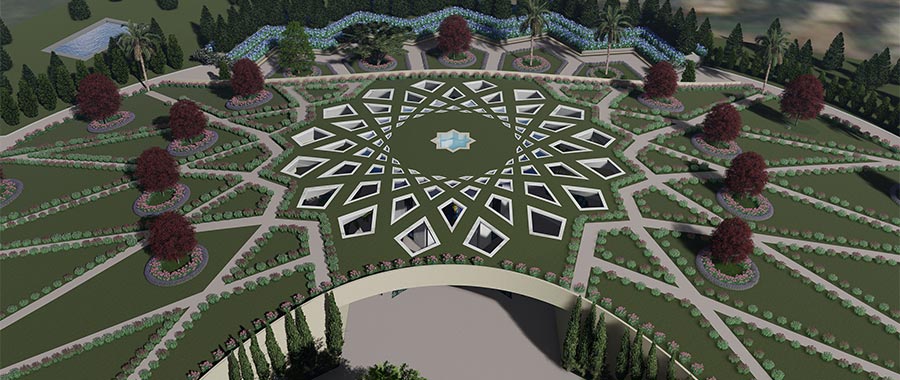The unveiling of the design concept for the Shrine of ‘Abdu’l-Bahá is not merely an architectural endeavor; it serves as an emblematic representation of profound spiritual principles. Like a luminous beacon casting its light across the tumultuous seas of modernity, the Shrine stands as a testimony to the Bahá’í Faith’s core tenets: unity, beauty, and reverence for the divine. This article elucidates the intricate layers of meaning encapsulated within the design of this sacred edifice and its implications for both individual and collective spiritual growth.
At the outset, one can regard the Shrine itself as a metaphorical bridge between the earthly realm and the transcendent. Where some may see mere stone and mortar, the Bahá’í vision transforms these elements into a sanctified vessel for divine inspiration. This architectural marvel seeks to connect disparate human souls through a shared reverence for ‘Abdu’l-Bahá, who exemplified the principles of compassion, equality, and service. Each corner and contour of the Shrine acts as an invitation, urging visitors and followers alike to transcend the materialistic barriers that divide humanity.
Central to understanding the design is the notion of beauty as an intrinsic manifestation of truth. The Shrine’s aesthetic, grounded in harmonic proportion and balanced symmetry, serves to elevate the spirit. It beckons the beholder to pause and reflect, much like the gentle yet persistent murmur of a brook invites one to contemplate the nature of existence. The interplay of form and function becomes an artistic dialogue, where each architectural element—be it a dome, arch, or column—whispers tales of divine love and human aspiration.
The geometrical patterns present in the design further encapsulate the unity of humanity. These patterns often symbolize interconnectedness, representing how individual lives weave a larger tapestry of shared experience. Just as a variety of colors can coalesce into a breathtaking masterpiece, so too can diverse cultures and religions find common ground in the embracing embrace of love and understanding. This aesthetic serves as a daily reminder that, despite our differences, we are all threads in the grand design of creation.
In the context of the Bahá’í teachings, the Shrine embodies not merely a physical space but also a metaphysical sanctuary. It offers a refuge from the chaos of everyday life—an ethereal realm where the human spirit can engage in contemplation and connection with the divine. Entering this sacred space allows individuals to embark on an introspective journey, facilitating both personal transformation and communal harmony. Within those hallowed walls, the teachings of ‘Abdu’l-Bahá echo through time, urging humanity toward a shared destiny of peace and collaboration.
The construction approaches employed in the Shrine reflect the Bahá’í commitment to sustainability and environmental stewardship. This foresight serves as not just a practical consideration but fundamentally aligns with the spiritual principles of the Faith—respect for creation and the responsibility of stewardship towards the world. Employing materials and techniques that honor the earth resonates deeply with the teachings, thereby harmonizing the physical structure with the overarching tenets of the Bahá’í worldview.
Moreover, the incorporation of gardens surrounding the Shrine further amplifies its allure. Gardens, in many cultures, symbolize paradise and divine beauty; they are spaces that invite tranquility and reflection. In the Bahá’í tradition, these cultivated landscapes serve as metaphors for spiritual growth. Just as a garden flourishes under attentive care, so too do the souls of individuals flourish when nurtured by the principles of love, service, and unity. Visitors to the Shrine are encouraged to immerse themselves in these gardens—spaces designed not only for aesthetic enjoyment but also for spiritual rejuvenation.
The design of the Shrine of ‘Abdu’l-Bahá transcends mere function; it is a dialogue between architectural elegance and spiritual profundity. As visitors enter the sacred space, they are not merely observers but participants in an ongoing conversation with the ideals that ‘Abdu’l-Bahá championed—love, peace, and the essential unity of mankind. Each visit becomes a pilgrimage, a transformative experience that resonates on both an individual and collective level.
Furthermore, the Shrine is poised to become a nexus of interfaith dialogue and communal gatherings, a hub where followers of all faiths can come together to explore the shared aspirations of humanity. As a physical manifestation of the Bahá’í teachings, it stands as a challenge to the divisive tendencies prevalent in contemporary society. It reminds us that true spirituality embodies the courage to engage with our differences while nurturing a profound appreciation for our common aspirations.
The design of the Shrine of ‘Abdu’l-Bahá unveils an artistic expression of core spiritual values that offer guidance for constructing a peaceful world. In its splendor, it encapsulates the essence of the Bahá’í Faith, serving as both an inspiration and a call to action. People who walk through its doors will find an invitation—not only to contemplate the divine but also to engage in the monumental task of building a more unified and harmonious world. The design, ultimately, becomes a statement of hope, a testament to the enduring power of faith, and an aesthetic celebration of our shared humanity.
